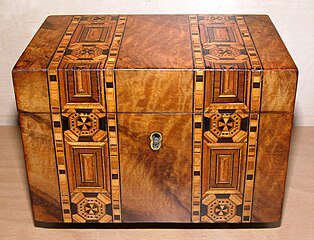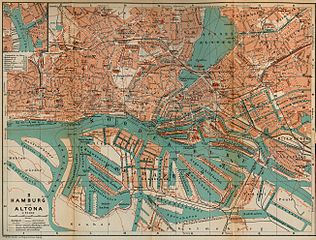Hamburg holds a special place in my heart not because it is a major hub for the world tea trade but today we will only focus on this aspect (sorry for those too curious about me).
I will first call everyone knowledgeable about this topic to tell me when I am wrong as it is a complex matter and information is few and people are not really ready to answer questions (or perhaps I didn’t ask the right persons or the right questions. Who knows?).

English tea box by Hannes Grobe (published under Creative Commons Attribution-Share Alike 2.5 Generic licence)
First, here is an extract of the website of the Port of Hamburg.
The Port of Hamburg has been the leading European trade centre for tea for many years. The major exporters are India, China, Sri Lanka and Indonesia.
Hamburg’s docks handle about 50 to 60 percent of the worldwide trade. Around 70 percent of the tea sold in Germany passes through Hamburg.
Imported teas are also blended and flavoured in Hamburg, before being exported worldwide. Great Britain and France are among the traditional destinations. About half the tea is shipped to the USA after being processed in Hamburg. The Russian market has also been gaining in importance recently.
Source: http://www.portofhamburg.com/en/content/tea
If you read the first paragraph, you might not understand why this happens since Germany is not known for its tea consumption (0.23 kg per capita and per year in 2009 according to the Food and Agriculture Organisation, which is even lower than the USA and far beyond the average yearly tea consumption per capita in the European Union (0.48 kg)).
However reading the second and third ones, you might begin to understand there is something as:
-
the Port of Hamburg is not only the major European tea port but also the biggest one at the world level
-
there seems to be a lot of further shipping (I won’t comment on the half of the tea shipped to the USA since I don’t have enough data for it).
Obviously, tea like other commodities is a trade where economies of scale is the name of the game for most companies (some won’t follow this strategy but most will).
Why? Because when you are big enough, you have more bargain power (look at articles on the Glencore-Xstrata merger) during the whole buying, transportation and processing chain.
This explains why once these companies have selected a hub, they are more than likely to put all their eggs in the same basket.
However this really quick analysis doesn’t help us to understand why Hamburg and why not Antwerpen or Rotterdam or Southampton.
Obviously, if a lot of companies involved in the tea business are there, it helps but it is not the only reason as companies move around, markets evolve…
So the explanation for the concentration lies not in the sole existence of what we could call a tea industry cluster (even if I think I might be exaggerating with the cluster thing).
In order to get a major tea port is adding to a tea industry cluster some historical background enough?

“Northern Germany as far as the Bavarian and Austrian Frontiers; Handbook for Travellers” by Karl Baedeker. Fifteenth Revised Edition. Leipzig, Karl Baedeker; New York, Charles Scribner’s Sons 1910. “Courtesy of the University of Texas Libraries, The University of Texas at Austin.”
The development of Hamburg in the colonial goods trade (coffee, tea, spice, cocoa, tobacco…) has its roots in the immigration of Protestant and Jews traders fleeing the religious conflicts of the 16th and 17th centuries.
These people came from different areas but also from the Netherlands and they brought with them their knowledge of these markets, their relations and their money.
Such was their success that in 1747, you could find in this town 246 coffee and tea traders and 267 in 1777.
The opening of the Chinese ports following the Opium War in 1842 and the end of England’s Navigation Acts in 1857 gave new opportunities to the tea business in Hamburg (If you want a more in depth analysis on Hamburg, its history and globalisation, you should read Capitalising on change in a globalising world by Wolfgang Michalski).
We now know that the tea industry has been concentrated in Hamburg for a long time.
But this is not enough as the following two examples will show.
Hamburg was the centre of Europe’s beer industry between the 14th and somewhere between the end of the 16th century and the middle of the 17th century. It was also the centre of Europe’s sugar industry between the end of the 17th century and the beginning of the 19th century.
Conditions and competitions changed and this two industries went away.
There is one final advantage provided to the tea industry that might explain it all. It is something that companies are always looking after, i.e. a financial incentive.
By financial incentive, I don’t mean subsidies but something more “subtle”, customs rights.
Yes you read it right, one of the main reasons behind Hamburg position is simple: part of it is a free port and it has been so since 1888 when the Free and Hanseatic City of Hamburg became part of the German Empire.

view from Poggenmühlenbrücke at Speicherstadt in Hamburg, Germany by Thomas Wolf, www.foto-tw.de.(published under Creative Commons-Lizenz Namensnennung-Weitergabe unter gleichen Bedingungen 3.0 Unportedc license)
This is a legal thing and the European Commission has approved it and published a list (http://eur-lex.europa.eu/LexUriServ/LexUriServ.do?uri=OJ:C:2002:050:0016:0018:EN:PDF).
The idea is simple: when you import goods in a free zone, you only pay import taxes when the goods leave this area.
When you apply this to a yearly stock, you understand why it is really interesting in financial terms.
To say it with other words, you imported 1,200 tons of tea at once, since you had a good price thanks to your bargaining power. You sell each month for 100 tons in the European Union. Thanks to the free zone status, you will only pay each month the import taxes for your monthly consumption.
You might then say that it explains the importance of the Port of Hamburg for the European Union but not for the rest of the world since everyone can do it in its own country and you would be right.
What I must add to this explanation is that when you re export our of the EU goods from a free zone after some allowed transformations (e.g. improving the live span of your product or putting it in a new packaging…), you don’t pay taxes at all.
Let’s use another example. You have bought 1,000 tons of tea and you imported them in the free zone part of the Port of Hamburg. You change their packaging to meet your customers needs and re export to the USA for 1,000 tons worth of tea in teabags. At the end of the year, you won’t pay any import or export taxes for the EU (not even on the raw teabags).
When you add all this, you can understand why Hamburg has such a dominant position in the tea world as the industry is there and the customs “easiness” too.
For any company with a focus on the economy of scale approach (remember I said most companies in the tea business are following this model whether they are in the bag tea business or in the loose leaves one), this is a winning situation.
Will this ever change?
YES because the status of part of Hamburg as a free zone will end in 2013.
Because of this, we might see some changes in the manufacturing, transportation and pricing strategies of the whole tea industry.
I told you in the title “free is the name of the game” but soon, it might become “we are living interesting times”.











Recent Comments